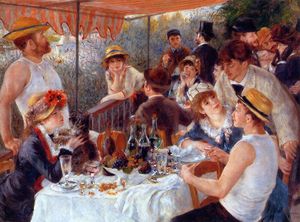Luncheon of the Boating Party Story-Theme
- Date of Creation:
- 1881
- Alternative Names:
- Le dejeuner des canotiers
- Height (cm):
- 130.20
- Length (cm):
- 175.60
- Medium:
- Oil
- Support:
- Canvas
- Subject:
- Scenery
- Framed:
- Yes
- Art Movement:
- Impressionism
- Created by:
- Current Location:
- Washington, District of Columbia
- Displayed at:
- Phillips Collection
- Owner:
- Phillips Collection
- Luncheon of the Boating Party Story-Theme Page's Content
- Story and Theme
Luncheon of the Boating Party Story and Theme
Luncheon of the Boating Party was painted in 1881 and is often referred to by its French name, Le déjeuner des canotiers. This canvas was produced at the height of Renoirs Impressionist career and is one of his last works capturing a sociable, pleasant scene from his early life.
Luncheon of the Boating Party shows a group of Renoirs friends relaxing and enjoying food, drinks, and good conversation on a balcony at the Maison Fournaise in Chatou, France. Renoir often included close friends is his paintings and they would model for him when needed. In Luncheon of the Boating Party Renoirs future wife, Aline Charigot, can be seen in the foreground playing with a small dog, and she is the only member of the group not engaging in conversation.
The Maison Fournaise was a popular meeting place for the new couple because Charigot loved to row and dance and the restaurant was in a prime location overlooking the Seine. Renoir conveyed his feelings for Aline at this time by separating her from the other cast members; she is the only subject who does not flirt with anyone but instead directs all of her attention at her dog. Renoir also reinforces Alines status in the painting by using brighter colors for her clothing. Luncheon of the Boating Party was painted early in the couple's relationship and is one of Renoir's first paintings of his wife-to-be.
Focusing on other cast members, in the right foreground of the painting wearing a straw hat is Gustave Caillebotte, one of Renoir's wealthy customers. Other subjects include the artist Paul Lhote, the amateur art historian, collector, and editor of the Gazette des Beaux-Arts Charles Ephrussi, French poet Jules Laforgue, actresses Ellen Andree, Jeanne Samary and Angele Legault, former mayor of colonial Saigon Baron Raoul Barbier, the restaurant proprietors children Louise-Alphonsine Fournaise and Alphonse Fournaise Jr, bureaucrat Eugene Pierre Lestringez, and Italian journalist Maggiolo.
At the time he started on this canvas Renoir was beginning to think that pure Impressionism carried out in the open was too limiting and so most of this canvas was painted in the studio. Renoir owned a studio near the Maison Fournaise where friends posed for him and he refined this canvas there before returning to Paris and completing the work in 1881.
However, this painting was not without its setbacks and in a letter written by Renoir in 1880 he suggests that he worked on individual subjects as they were available but that he was not happy with the progress being made: "I no longer know where I am with it, except that it is annoying me more and more. " It was often difficult for Renoir to assemble his cast members and the size of this canvas meant that it took a great deal of funding to complete.
Renoir made numerous changes to the painting, adding in individual figures when his models were available, and he included the striped awning along the top edge later on.
The canvas sold in 1881 to Paul Durand-Ruel, a huge supporter and collector of the artists work. It remained in his private collection until 1923, when his sons sold it to Duncan Phillips. The painting can still be seen in the Phillips Collection today and is one of the most famous works of art on display.
One of Renoirs most recognizable works, Luncheon of the Boating Party is instantly recognizable and it is symbolic of this period in history and exhibits Impressionism at its very best.




